How is the long-distance passenger car
A modern car, when connected to the rest of the train, is automatically included in the local network and receives parameters from the headquarters car server. In the single-storey car of the Tver Carriage Works, now there are about 280 parameters in monitoring (starting from the filling level of the faecal tank and ending with the battery voltage), and in the two-story

car - about 400. We start with intercar connections. These are the pneumatic brake line (the pneumatic hoses that connect the cars to each other, the railroad workers call them “frogs”), the high-voltage line, the emergency line 110 V, an intercom and local area network, plus radio relay bridges between the cars in case of a local network break.
The cars are connected by a pneumatic line. As in the subway, to keep the brakes in the released state, it maintains a pressure of a certain level (approximately 5 atm). In this case, it is said that the brake line is charged, in order to brake the train, it is necessary to reduce the pressure in the line. Then the brakes will come into action.
If the train suddenly disengages, then the first thing that happens is that the pressure in the brake line will drop and it will stop almost immediately.
If you disrupt the direct-action stop-valve, then you simply open the brake line access to the atmosphere and air evolves from there. The composition, respectively, also stop. While the highway is not charging, the train will not go further, because it will stand on the brakes.
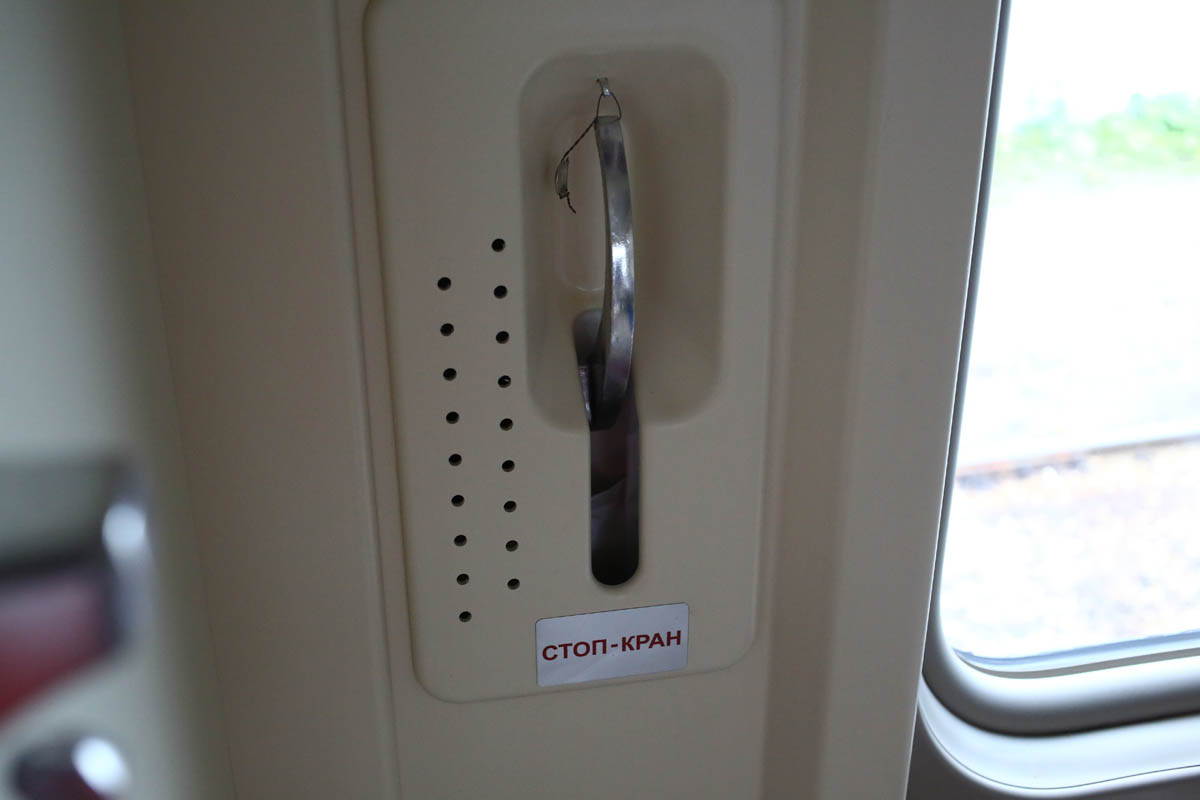
In some modern passenger cars and electric trains, stop-valves of direct action remain only at one point, the rest are replaced with stop-valves of indirect action, which send an emergency stop signal to the cab of an electric locomotive or locomotive. In this case, the driver is given some time (usually about 5 seconds) to make a decision about allowing or prohibiting emergency braking.
With a speed of 160 km / h, the stopping distance is one and a half kilometers. The lower the speed of the car, the sharper the stop. There is nothing fatal in stopping a stopcock for a car - it doesn’t wear out beyond measure. But passengers unpleasantly shake, some (who did not put forward the handrail, was drunk or did not use straps) would fall off the shelves.
Here is a separate post about the power of the passenger car and heating boiler. Very briefly, the plot looks like this: there are inputs (generator from rotation of a wheelset, a high-voltage highway 3000 V from an electric locomotive, emergency 110 V from a neighboring car), there is a rechargeable battery and there is a control and control module (own needs converter) so that everything goes right, and converts the current into the required format for electrical consumers, 110 V of the on-board network, 5 V USB sockets and so on.
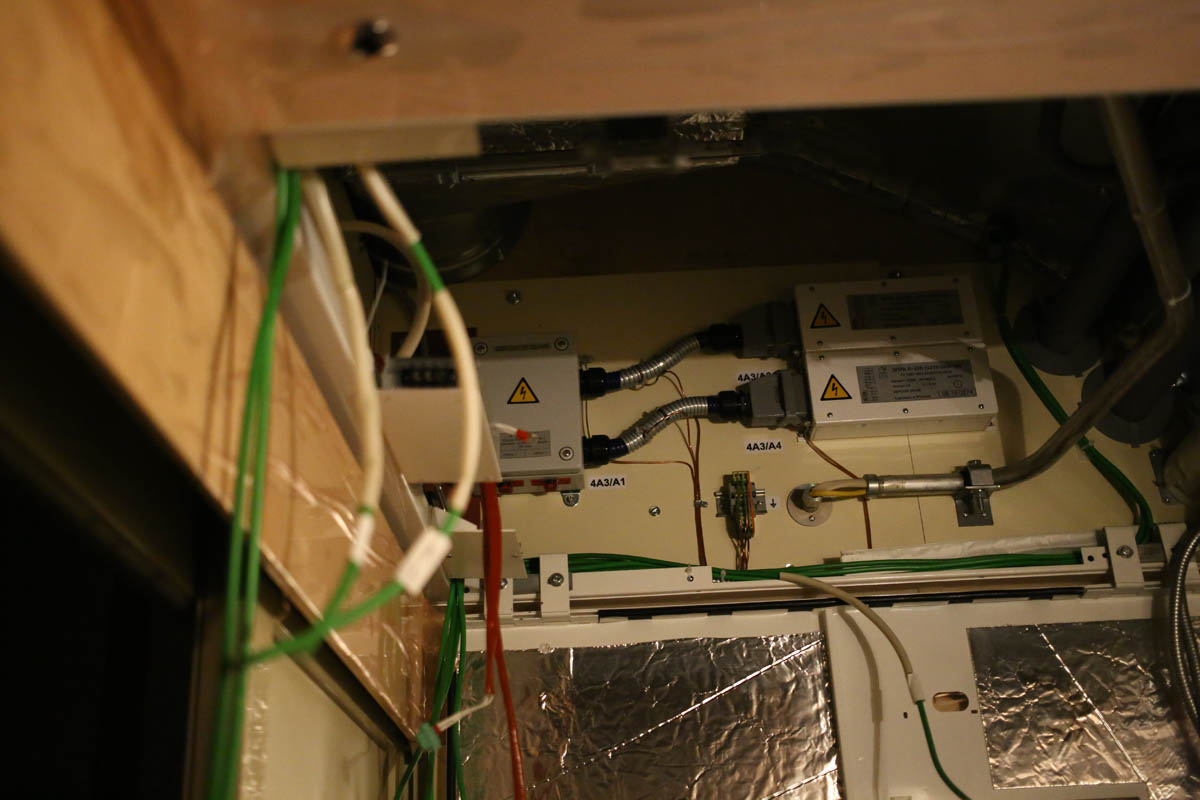
USB sockets on the upper shelves:
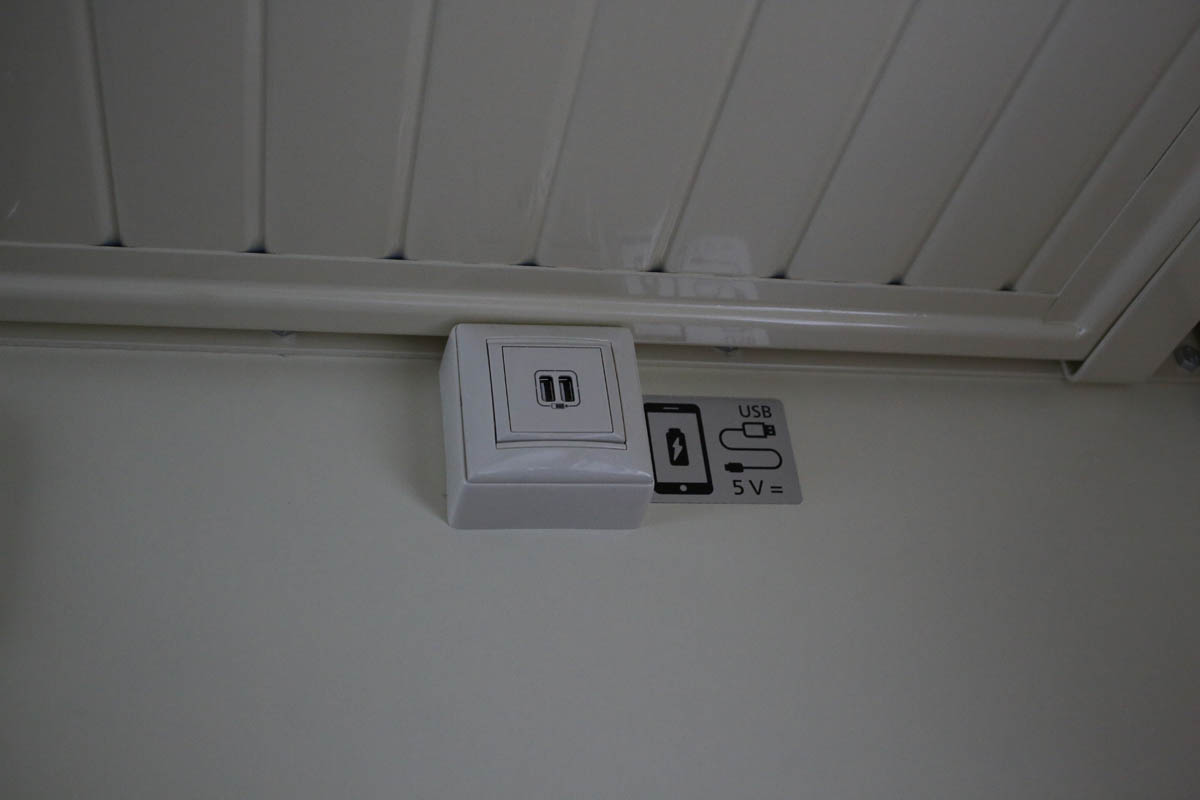
220-volt sockets on the lower shelves:

Why is 220 V below and 5 V above? According to the safety rules, dangerous voltage should not be raised above a certain height. Conditionally, so that the passenger from above does not boil water on the sly there and does not start pouring it down. As a rule, such requirements do not appear from scratch - apparently, there were precedents.
The cars are connected by the backbone of the local network (it was 100 Mbps, now on the new cars 1 Gb / s) and by radio. Antenna-feeder devices are installed outside on the end walls of the car, they are often mistaken for lights. Radio used to be 10 Mb / s, today it is already 100 Mb / s according to the standard.
All this is necessary so that you can use Wi-Fi, and the conductors can call each other via IP-telephony in the local network, plus for transmitting technical data (more on this in more detail later). In the meantime, it is important that Wi-Fi is usually set up so that even in the absence of access to a large Internet, you are usually allowed to a local media server (located in the headquarters car) from which you can watch the movie. Televisions in the compartment are also arranged in a coupe - even in the area without a network, passengers can agree on what they are watching and receive stream from the staff car.
Today, there are usually about 150 customers of the information network per train.
The information network also contains a board that shows the occupancy of the toilet, the temperature and the route inside the car:

The data from the infoset takes the board with the car number (those that look outside) - the car automatically determines its place in the train, you don’t need to set anything up (only the location of the staff car in the train, because the car knows who is in front of it and who behind him, but does not know where the head and where the tail of the composition).
In 2018, the scoreboard can also display arbitrary content. So wait for the action from the dining car, videos about security and the weather outside.
There is also an audio mainline - this is an intercar radio. The head of the train makes an announcement on it, music plays on it. According to him, you will be woken up on arrival, if this is the final destination for the train.
There are hand swing, they are probably perfectly familiar to you. There are also electromechanical doors.
We tried to make pneumatic ones, like in the Moscow metro (I think it was the Nevsky Express), but then, based on the operating results, they decided to switch to electrics. Air must be taken somewhere (the passenger car does not have a compressor unit to provide itself with air), and it is much easier to get electricity and then serve it. But, as the engineer says, “the metro is a rolling stock that still works in special operating conditions. It is warm and dry, served daily. For passenger cars, other, more “rare” routine maintenance intervals are established, therefore we lay down reliability and simplicity. The doors have a manual mode of operation: turn off the power supply and manually open the handle with a cable. ”
Now the doors of TVZ cars with electromechanical drive. There is a 24-volt "screwdriver" engine. The rotation of the engine due to the pulleys and the toothed belt is converted into a forward movement of the door.
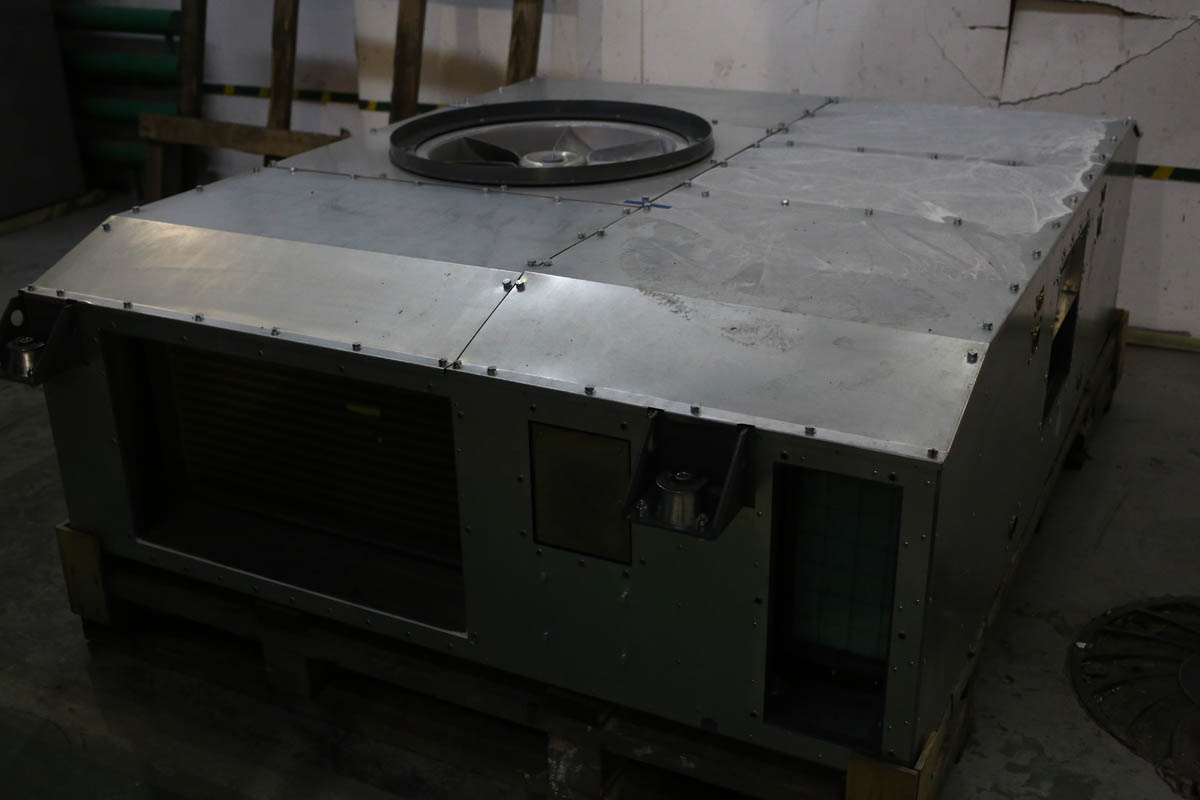
On the car there is an air conditioning unit (air conditioner). In the photo above it is at the factory just before installation. It takes the outside air, cools or heats it and then distributes it through the air ducts around the premises of the car. Then he takes the recirculated air from the passenger compartment, mixes it with the outboard and sends it back to the carriage. This is done to save energy: the greater the use of recirculating air, the greater the energy savings. In this case, of course, we must not forget about the need to comply with sanitary rules and regulations.
For air there is a disinfection unit, it is in the same unit with air conditioning. There is a package of UV lamps, so if someone is sick, his bacilli becomes corpses when they pass through the air conditioner. What does not exclude direct infection in the car (as in any crowded place), but significantly reduces the chances of such an outcome.
The second disinfection unit is in the water circuit for non-potable water. Drinking used to be made from the technical method of boiling, and today it is taken from the cooler (from a pre-loaded bottle, as in the office). But the wash water is disinfected. Under the roof of the car above the toilets there is a tank (1100 liters in modern one-storeyed cars). This water is taken from a gas station in the parking lot, it is not always of good quality: there may be sand and silt, for example. To disinfect this water, you need to pass it through a container with a flask with UV lamps. It will not remove sand and impurities, but microorganisms will be killed.
About heating was in the post about the boiler .

In most of the cars, there is no separate room for a shower (there are in the SV double, comfort-cars and in the headquarters). In the headquarters compartment for passengers with disabilities and their accompanying persons, by the way. But each toilet has a shower head (sometimes hidden behind the panel) and a hole in the floor.

In most cars, the parameters of temperature and air velocity in the air conditioning system are the same for all. In winter, the setting is 24 ° C, in summer - 22. There are no dynamically adjustable dampers at specific points on the car. If there is a system of purchasing temperature regulation (several modifications were made at TVZ), everything is more complicated and trickier there, but it is more expensive for the carrier.
The most commonly used refrigerant R134 mixture. To ensure the possibility of heating the air in the air conditioner there is a liquid heater (in single-deck cars) and an electric heater (in double-deck cars). Fans are needed to ensure the movement of air through the car. In the liquid heating system there is a pump for the forced circulation of the coolant (water) at extreme temperatures.
In the two-story car there are three toilets, that is, one more, and two air conditioners.
All these wonders are managed either from a conductor compartment, or using an application that is accessible by certificate and only when connected to the local area network of the car.
If you open the door with a touch screen with a key of the conductor, then the control of the car will be available in manual mode (ignoring remote access) and you can press the buttons.
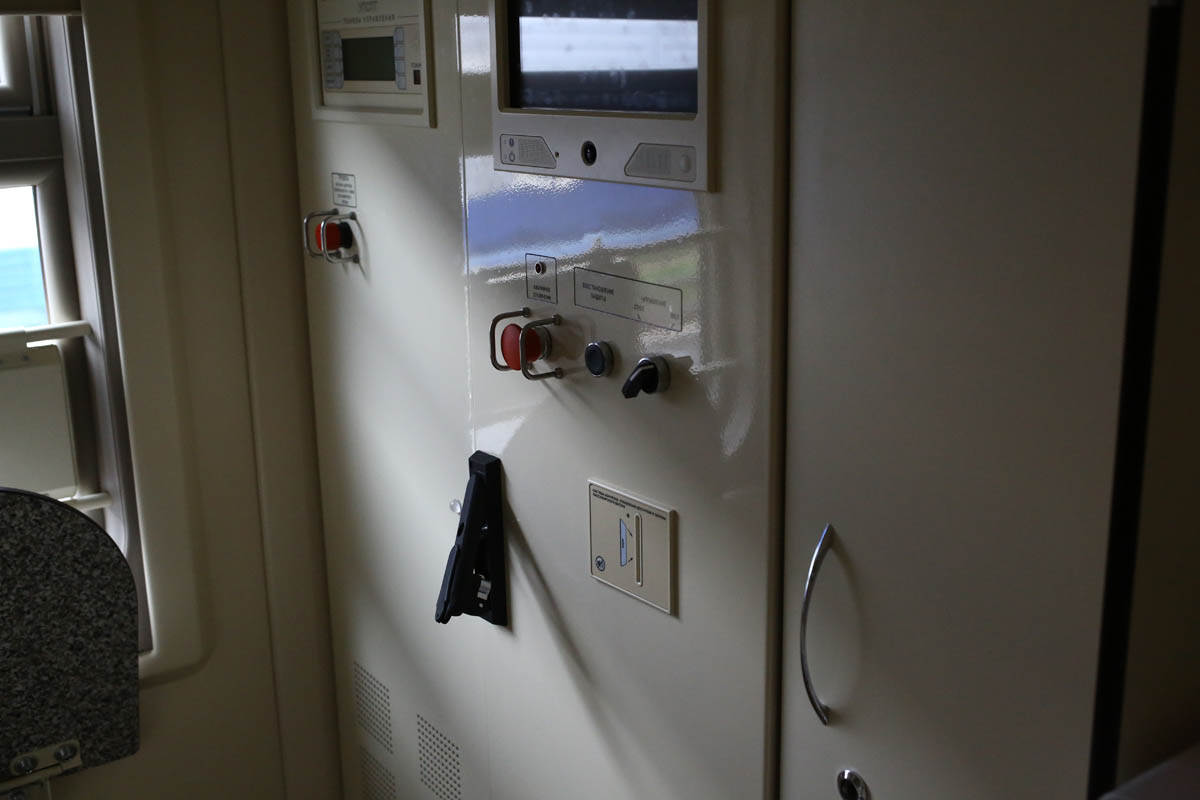
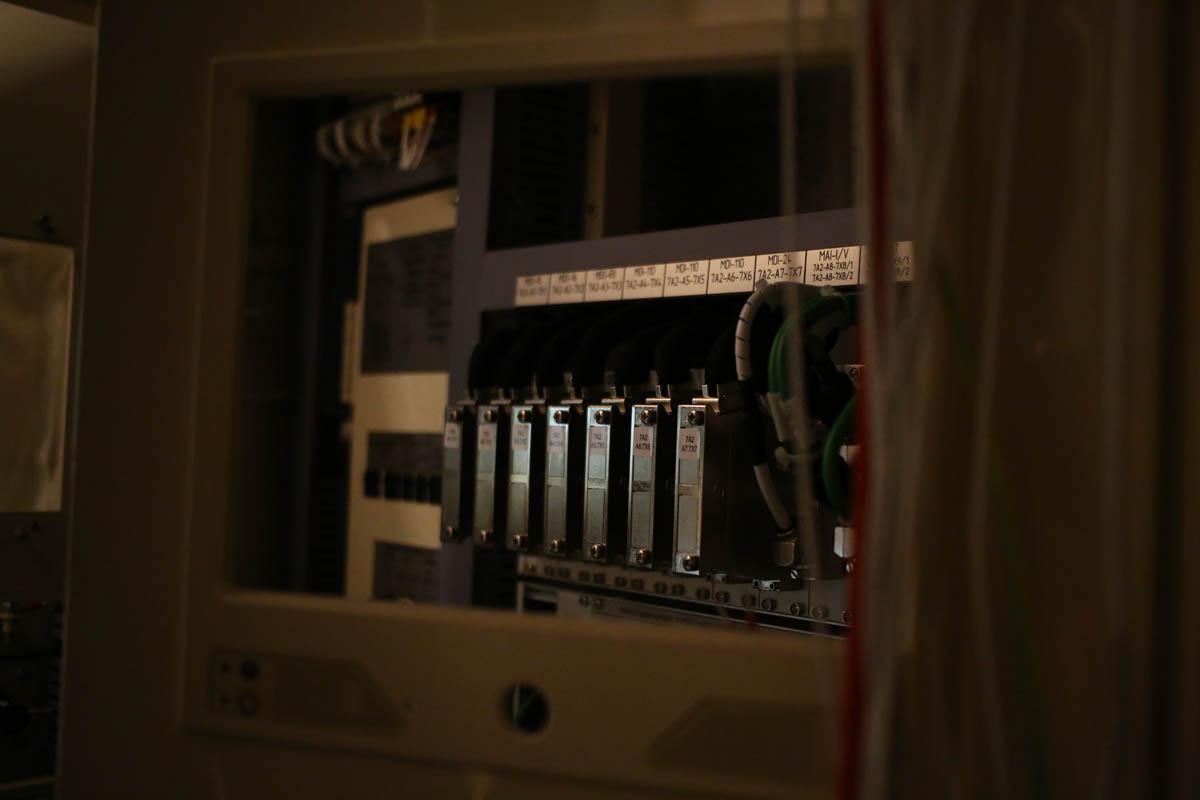

In the same place, next to the panel, there will be hands-

on instruments and in general everything is legacy: We need to dwell on the management for more monitoring.
So that the conductor’s compartment does not look like a cockpit, and in order to be able to manage everything more easily, we made a graphical, intuitive interface:
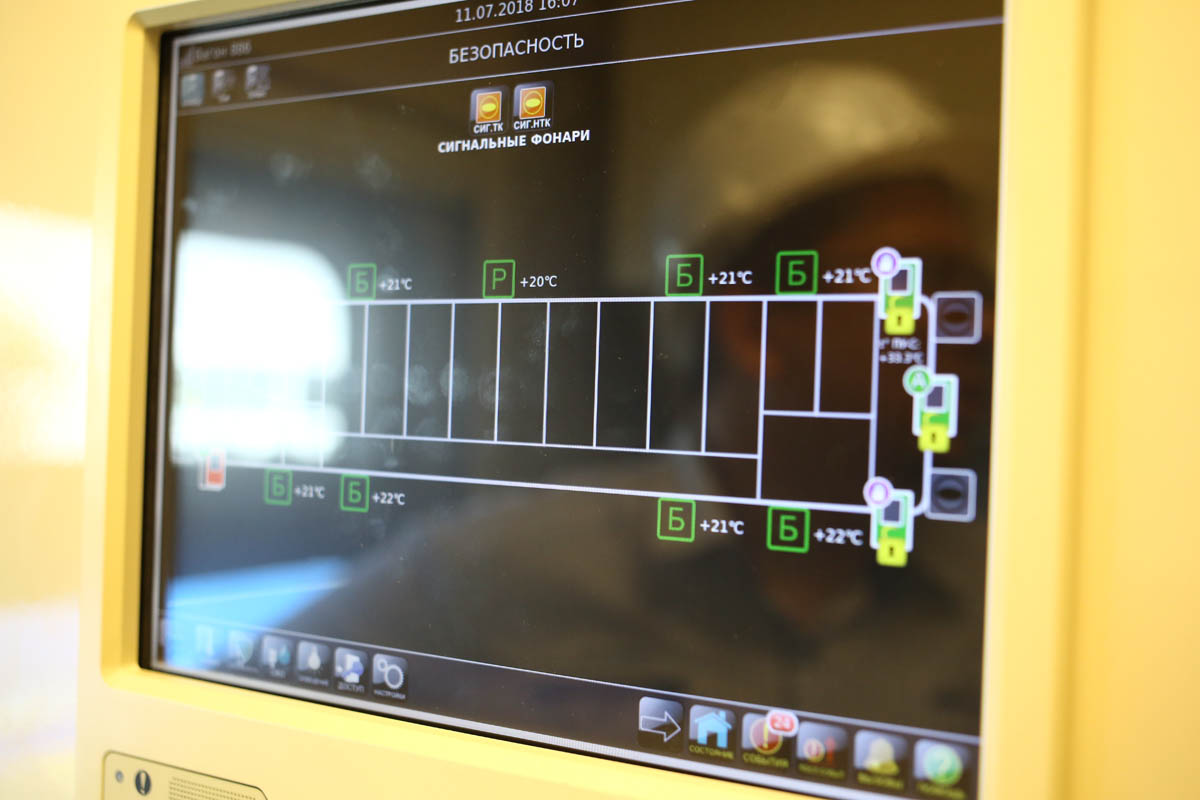
At the same time, technical progress went in the direction of automation and a module was needed that ensures the performance of various actions that the conductor had done before. For example, without switching to manual mode, you cannot remotely (from the local network of the train) open the exterior doors at a speed of more than 5 kilometers per hour, at a critical battery charge level, the lighting starts switching from fluorescent lamps to LED “night”, there are whole groups of scripts on one button (for example, climate control) and so on.

Along with automation, logging of all actions and the ability to see the status of each subsystem in the headquarters car came.

Today, each device of the car is designed autonomous, but with information output to the local monitoring network. That is, while there are three levels of devices:
This is done because the local train network and the passenger network are not yet separated. In general, the local network of the train appeared historically because of the need to distribute Wi-Fi and evolved from the trunk on a twisted pair, passing through the whole train and connecting through inter-car hitch (oh, woe to you, if there was a ring). This is not the most appropriate security solution, but it is now winding up. In Europe, the situation is worse; the info-mall has evolved from CAN buses, which makes it much less flexible in development.
Then the subsystem control and logs were “built up” from above, since it was very convenient. The next step is remote control of the car from the carrier’s monitoring center, but it cannot be done because:
If we recall the situation when, through Wi-Fi, one of the passengers connected to the interface of the conductor, it becomes clear why. In that story, when servicing the car, two modules were conditionally confused: for the conductor and for the passengers. Well, yes, he would be able to warm up the car to +45, but hardly more. Although it is also unpleasant. The conductor would notice something amiss and switch to manual mode (which would immediately turn off the entire control unit).
But so that this does not repeat exactly, the networks are now physically separated. More precisely, they are going. While the cars, even the newest, with a common network.
How are car logs used? The most important messages are written to a short log and sent via the Internet to the carrier’s servers. Conventionally, these are the states of the systems after the next ferry plus the actions of the conductor. The carrier has a task to analyze the failures, so that according to the profile of the already repaired cars, to guess when it will be time to prophylactically change something in what is still looking normal. This in perspective allows you to save a lot, because it is better to replace an almost dead node in the depot than to face a breakdown on the way.
Monitoring can be seen from the headquarters car.
Critical logs (failure messages) on sites without the Internet can be sent via SMS. Also, the device has a small buffer that saves the log before arriving at the section of the path where there is a stable connection.
The car can also be switched to debug mode, and then it will write everything to the log.
For an hour you can dial a gigabyte of raw logs in debug mode.
In the same device there is all the documentation for the car:
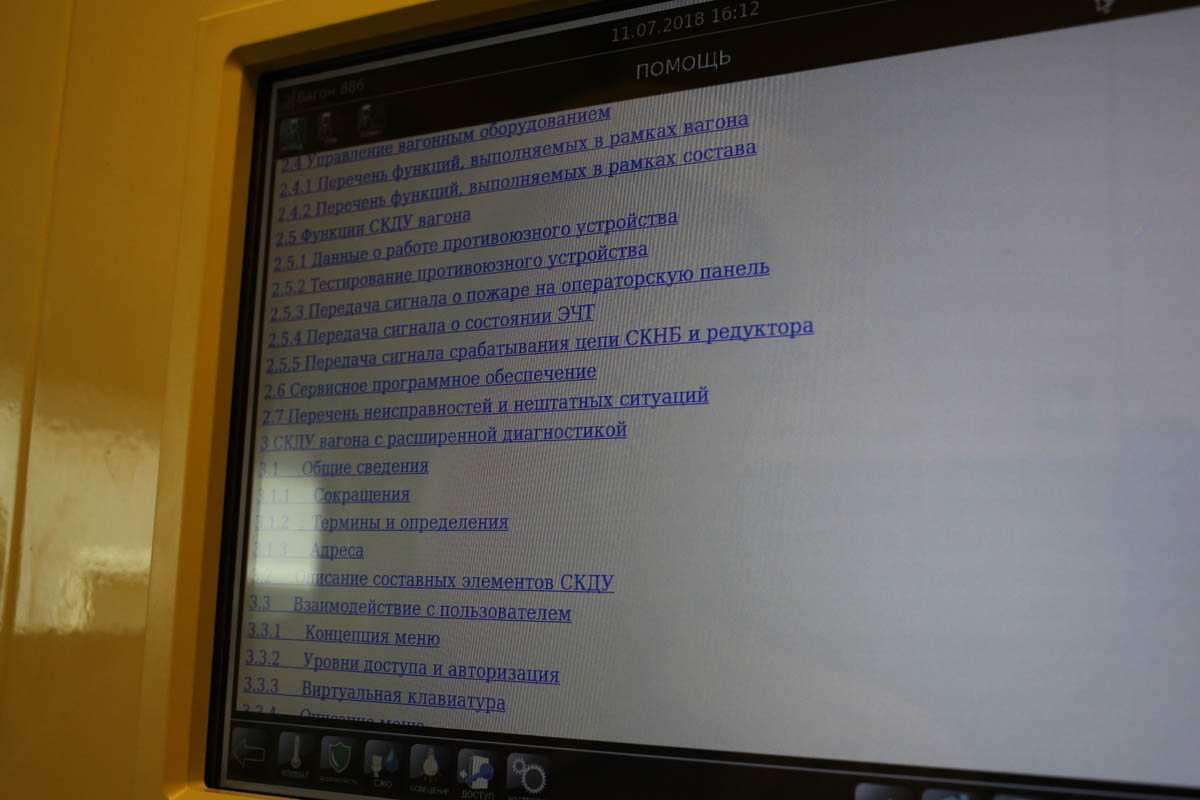
In the administrator mode, you can get more data about the subsystems:




And in the engineer mode, you can run tests of some subsystems:

Modern toilets on TVZ cars are vacuum and arranged in one side of the car. In general, the new car is very easy to distinguish by steep automatic doors and toilets on one side. The reason for this is simple: vacuum compressor units are needed for flushing. When the toilets are at the two ends of the car, either two installations are needed, or a track under the car. Two installations are expensive, there was also a series of cars with the highway, but it was noisy. Especially at night, when someone was washing off in that part of the car, where there is no installation, - hellish sound went through all the compartments.
The toilet tank on the single-storey buildings is located under the car, there is no place to climb on the two-storey cars, almost everything inside the car. Therefore, it is inside about the toilet. On an ordinary car, the tank “on the street” also has a heating, so that the waste does not freeze tightly. Because then the procedure of repairing the tank turns into something incredible. Heating is electric and liquid tosol: the snake of the pipeline - and away we go. In order to keep the antifreeze warm, it is heated from indirect contact with a water heating pipe. On a double-deck car, the tank is inside the car and has no heating system.
The narrowest, in the literal sense of the word, place for a modern toilet is a hole in the toilet bowl. If it crawled into it, then it will not stop further. If the cup does not crawl, and someone shoved a mop, there are chances to break the rubber-metal shut-off valve. And the fun story is waiting for everyone.
An even more interesting breakdown was on installations of the old type. The combination of the fecal tank without additional stiffeners and maintaining negative overpressure in the tank itself (now it is already supported only in the pumping system) led to the fact that sometimes there was a surprise. A few random wrong movements, damage - and the tanks collapsed under vacuum. Rumor has it that passengers who have committed these gross operational errors, still very carefully go to the toilets, even at home.
The carriage stands on bogies whose frames rest on wheel sets. At first they were just hard, then, with increasing speeds, springs began to appear there, and today a modern pneumatic suspension. Here is from a long-distance passenger car:

But from the Oriole electric train:

Everything. As you can see, the cars are small spaceships.

car - about 400. We start with intercar connections. These are the pneumatic brake line (the pneumatic hoses that connect the cars to each other, the railroad workers call them “frogs”), the high-voltage line, the emergency line 110 V, an intercom and local area network, plus radio relay bridges between the cars in case of a local network break.
Brake system
The cars are connected by a pneumatic line. As in the subway, to keep the brakes in the released state, it maintains a pressure of a certain level (approximately 5 atm). In this case, it is said that the brake line is charged, in order to brake the train, it is necessary to reduce the pressure in the line. Then the brakes will come into action.
If the train suddenly disengages, then the first thing that happens is that the pressure in the brake line will drop and it will stop almost immediately.
If you disrupt the direct-action stop-valve, then you simply open the brake line access to the atmosphere and air evolves from there. The composition, respectively, also stop. While the highway is not charging, the train will not go further, because it will stand on the brakes.

In some modern passenger cars and electric trains, stop-valves of direct action remain only at one point, the rest are replaced with stop-valves of indirect action, which send an emergency stop signal to the cab of an electric locomotive or locomotive. In this case, the driver is given some time (usually about 5 seconds) to make a decision about allowing or prohibiting emergency braking.
With a speed of 160 km / h, the stopping distance is one and a half kilometers. The lower the speed of the car, the sharper the stop. There is nothing fatal in stopping a stopcock for a car - it doesn’t wear out beyond measure. But passengers unpleasantly shake, some (who did not put forward the handrail, was drunk or did not use straps) would fall off the shelves.
Power supply
Here is a separate post about the power of the passenger car and heating boiler. Very briefly, the plot looks like this: there are inputs (generator from rotation of a wheelset, a high-voltage highway 3000 V from an electric locomotive, emergency 110 V from a neighboring car), there is a rechargeable battery and there is a control and control module (own needs converter) so that everything goes right, and converts the current into the required format for electrical consumers, 110 V of the on-board network, 5 V USB sockets and so on.

USB sockets on the upper shelves:

220-volt sockets on the lower shelves:

Why is 220 V below and 5 V above? According to the safety rules, dangerous voltage should not be raised above a certain height. Conditionally, so that the passenger from above does not boil water on the sly there and does not start pouring it down. As a rule, such requirements do not appear from scratch - apparently, there were precedents.
Intercom
The cars are connected by the backbone of the local network (it was 100 Mbps, now on the new cars 1 Gb / s) and by radio. Antenna-feeder devices are installed outside on the end walls of the car, they are often mistaken for lights. Radio used to be 10 Mb / s, today it is already 100 Mb / s according to the standard.
All this is necessary so that you can use Wi-Fi, and the conductors can call each other via IP-telephony in the local network, plus for transmitting technical data (more on this in more detail later). In the meantime, it is important that Wi-Fi is usually set up so that even in the absence of access to a large Internet, you are usually allowed to a local media server (located in the headquarters car) from which you can watch the movie. Televisions in the compartment are also arranged in a coupe - even in the area without a network, passengers can agree on what they are watching and receive stream from the staff car.
Today, there are usually about 150 customers of the information network per train.
The information network also contains a board that shows the occupancy of the toilet, the temperature and the route inside the car:

The data from the infoset takes the board with the car number (those that look outside) - the car automatically determines its place in the train, you don’t need to set anything up (only the location of the staff car in the train, because the car knows who is in front of it and who behind him, but does not know where the head and where the tail of the composition).
In 2018, the scoreboard can also display arbitrary content. So wait for the action from the dining car, videos about security and the weather outside.
There is also an audio mainline - this is an intercar radio. The head of the train makes an announcement on it, music plays on it. According to him, you will be woken up on arrival, if this is the final destination for the train.
Doors
There are hand swing, they are probably perfectly familiar to you. There are also electromechanical doors.
We tried to make pneumatic ones, like in the Moscow metro (I think it was the Nevsky Express), but then, based on the operating results, they decided to switch to electrics. Air must be taken somewhere (the passenger car does not have a compressor unit to provide itself with air), and it is much easier to get electricity and then serve it. But, as the engineer says, “the metro is a rolling stock that still works in special operating conditions. It is warm and dry, served daily. For passenger cars, other, more “rare” routine maintenance intervals are established, therefore we lay down reliability and simplicity. The doors have a manual mode of operation: turn off the power supply and manually open the handle with a cable. ”
Now the doors of TVZ cars with electromechanical drive. There is a 24-volt "screwdriver" engine. The rotation of the engine due to the pulleys and the toothed belt is converted into a forward movement of the door.
Climate control

On the car there is an air conditioning unit (air conditioner). In the photo above it is at the factory just before installation. It takes the outside air, cools or heats it and then distributes it through the air ducts around the premises of the car. Then he takes the recirculated air from the passenger compartment, mixes it with the outboard and sends it back to the carriage. This is done to save energy: the greater the use of recirculating air, the greater the energy savings. In this case, of course, we must not forget about the need to comply with sanitary rules and regulations.
For air there is a disinfection unit, it is in the same unit with air conditioning. There is a package of UV lamps, so if someone is sick, his bacilli becomes corpses when they pass through the air conditioner. What does not exclude direct infection in the car (as in any crowded place), but significantly reduces the chances of such an outcome.
The second disinfection unit is in the water circuit for non-potable water. Drinking used to be made from the technical method of boiling, and today it is taken from the cooler (from a pre-loaded bottle, as in the office). But the wash water is disinfected. Under the roof of the car above the toilets there is a tank (1100 liters in modern one-storeyed cars). This water is taken from a gas station in the parking lot, it is not always of good quality: there may be sand and silt, for example. To disinfect this water, you need to pass it through a container with a flask with UV lamps. It will not remove sand and impurities, but microorganisms will be killed.
About heating was in the post about the boiler .

In most of the cars, there is no separate room for a shower (there are in the SV double, comfort-cars and in the headquarters). In the headquarters compartment for passengers with disabilities and their accompanying persons, by the way. But each toilet has a shower head (sometimes hidden behind the panel) and a hole in the floor.

In most cars, the parameters of temperature and air velocity in the air conditioning system are the same for all. In winter, the setting is 24 ° C, in summer - 22. There are no dynamically adjustable dampers at specific points on the car. If there is a system of purchasing temperature regulation (several modifications were made at TVZ), everything is more complicated and trickier there, but it is more expensive for the carrier.
The most commonly used refrigerant R134 mixture. To ensure the possibility of heating the air in the air conditioner there is a liquid heater (in single-deck cars) and an electric heater (in double-deck cars). Fans are needed to ensure the movement of air through the car. In the liquid heating system there is a pump for the forced circulation of the coolant (water) at extreme temperatures.
In the two-story car there are three toilets, that is, one more, and two air conditioners.
Control
All these wonders are managed either from a conductor compartment, or using an application that is accessible by certificate and only when connected to the local area network of the car.
If you open the door with a touch screen with a key of the conductor, then the control of the car will be available in manual mode (ignoring remote access) and you can press the buttons.



In the same place, next to the panel, there will be hands-

on instruments and in general everything is legacy: We need to dwell on the management for more monitoring.
So that the conductor’s compartment does not look like a cockpit, and in order to be able to manage everything more easily, we made a graphical, intuitive interface:

At the same time, technical progress went in the direction of automation and a module was needed that ensures the performance of various actions that the conductor had done before. For example, without switching to manual mode, you cannot remotely (from the local network of the train) open the exterior doors at a speed of more than 5 kilometers per hour, at a critical battery charge level, the lighting starts switching from fluorescent lamps to LED “night”, there are whole groups of scripts on one button (for example, climate control) and so on.

Along with automation, logging of all actions and the ability to see the status of each subsystem in the headquarters car came.

Today, each device of the car is designed autonomous, but with information output to the local monitoring network. That is, while there are three levels of devices:
- Those that are in the local network and can take commands (for example, climate control, lighting).
- Those that are in the local network, but cannot accept commands or cannot receive critical commands (for example, the doors may lock but not open, you also cannot launch a series of emergency actions). Most devices of this type simply write data to the log.
- Those that are not visible on the local network. For example, the pneumatic pipeline cannot be controlled today and does not write anything to the log (but the brakes that use it can write to the log).
This is done because the local train network and the passenger network are not yet separated. In general, the local network of the train appeared historically because of the need to distribute Wi-Fi and evolved from the trunk on a twisted pair, passing through the whole train and connecting through inter-car hitch (oh, woe to you, if there was a ring). This is not the most appropriate security solution, but it is now winding up. In Europe, the situation is worse; the info-mall has evolved from CAN buses, which makes it much less flexible in development.
Then the subsystem control and logs were “built up” from above, since it was very convenient. The next step is remote control of the car from the carrier’s monitoring center, but it cannot be done because:
- According to the security requirements, commands cannot be given except from the local network.
- For security requirements, there is nothing that can critically harm the train, to which a command from the local network can be given.
If we recall the situation when, through Wi-Fi, one of the passengers connected to the interface of the conductor, it becomes clear why. In that story, when servicing the car, two modules were conditionally confused: for the conductor and for the passengers. Well, yes, he would be able to warm up the car to +45, but hardly more. Although it is also unpleasant. The conductor would notice something amiss and switch to manual mode (which would immediately turn off the entire control unit).
But so that this does not repeat exactly, the networks are now physically separated. More precisely, they are going. While the cars, even the newest, with a common network.
How are car logs used? The most important messages are written to a short log and sent via the Internet to the carrier’s servers. Conventionally, these are the states of the systems after the next ferry plus the actions of the conductor. The carrier has a task to analyze the failures, so that according to the profile of the already repaired cars, to guess when it will be time to prophylactically change something in what is still looking normal. This in perspective allows you to save a lot, because it is better to replace an almost dead node in the depot than to face a breakdown on the way.
Monitoring can be seen from the headquarters car.
Critical logs (failure messages) on sites without the Internet can be sent via SMS. Also, the device has a small buffer that saves the log before arriving at the section of the path where there is a stable connection.
The car can also be switched to debug mode, and then it will write everything to the log.
For an hour you can dial a gigabyte of raw logs in debug mode.
In the same device there is all the documentation for the car:

In the administrator mode, you can get more data about the subsystems:




And in the engineer mode, you can run tests of some subsystems:

Restroom
Modern toilets on TVZ cars are vacuum and arranged in one side of the car. In general, the new car is very easy to distinguish by steep automatic doors and toilets on one side. The reason for this is simple: vacuum compressor units are needed for flushing. When the toilets are at the two ends of the car, either two installations are needed, or a track under the car. Two installations are expensive, there was also a series of cars with the highway, but it was noisy. Especially at night, when someone was washing off in that part of the car, where there is no installation, - hellish sound went through all the compartments.
The toilet tank on the single-storey buildings is located under the car, there is no place to climb on the two-storey cars, almost everything inside the car. Therefore, it is inside about the toilet. On an ordinary car, the tank “on the street” also has a heating, so that the waste does not freeze tightly. Because then the procedure of repairing the tank turns into something incredible. Heating is electric and liquid tosol: the snake of the pipeline - and away we go. In order to keep the antifreeze warm, it is heated from indirect contact with a water heating pipe. On a double-deck car, the tank is inside the car and has no heating system.
The narrowest, in the literal sense of the word, place for a modern toilet is a hole in the toilet bowl. If it crawled into it, then it will not stop further. If the cup does not crawl, and someone shoved a mop, there are chances to break the rubber-metal shut-off valve. And the fun story is waiting for everyone.
An even more interesting breakdown was on installations of the old type. The combination of the fecal tank without additional stiffeners and maintaining negative overpressure in the tank itself (now it is already supported only in the pumping system) led to the fact that sometimes there was a surprise. A few random wrong movements, damage - and the tanks collapsed under vacuum. Rumor has it that passengers who have committed these gross operational errors, still very carefully go to the toilets, even at home.
Trolleys
The carriage stands on bogies whose frames rest on wheel sets. At first they were just hard, then, with increasing speeds, springs began to appear there, and today a modern pneumatic suspension. Here is from a long-distance passenger car:

But from the Oriole electric train:

Everything. As you can see, the cars are small spaceships.
